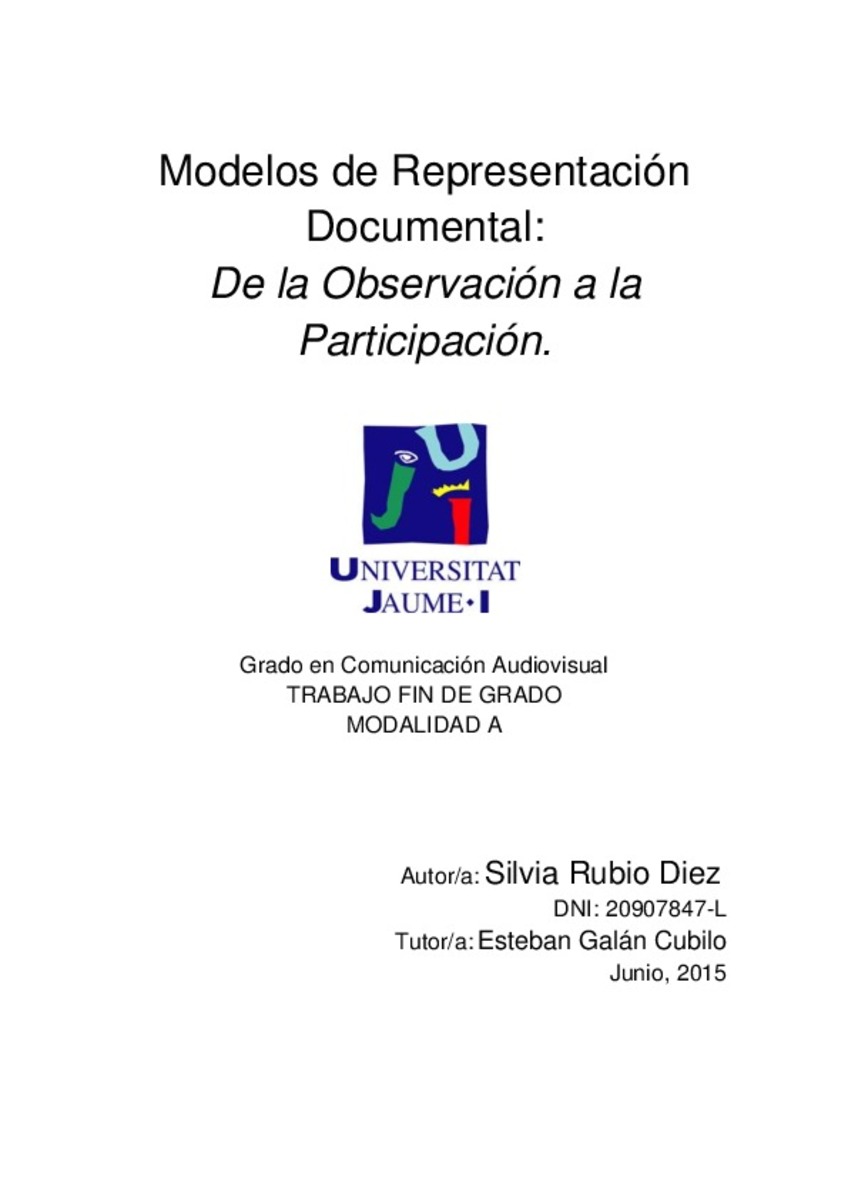Mostrar el registro sencillo del ítem
Modelos de Representación Documental: De la Observación a la Participación
| dc.contributor | Galán Cubillo, Esteban | |
| dc.contributor.author | Rubio Díez, Silvia | |
| dc.contributor.other | Universitat Jaume I. Departament de Ciències de la Comunicació | |
| dc.date.accessioned | 2015-12-16T09:10:32Z | |
| dc.date.available | 2015-12-16T09:10:32Z | |
| dc.date.issued | 2015-07-06 | |
| dc.identifier.uri | http://hdl.handle.net/10234/143786 | |
| dc.description | Treball de Final de Grau en Comunicació Audiovisual. Codi: CA0932. Curs acadèmic 2014-2015 | ca_CA |
| dc.description.abstract | En el siguiente trabajo se realizará un análisis de los nuevos modelos de representación documental, concretamente del paso del modelo de representación observacional al modelo participativo. Para llevar a cabo este análisis se estudiarán dos programas documentales, que tratan conceptos semejantes y que utilizan mecanismos y técnicas, tanto clásicas como modernas, con la intención de reducir los filtros entre la realidad representada y el espectador, para conseguir una conexión con la realidad. Estos programas son “Pueblo de Dios” y “Acción Directa”, emitidos por Televisión Española. El fin del estudio es descubrir si gracias al modelo participativo el documental consigue reducir los filtros discursivos y si consigue un punto de vista diferente de la realidad representada, por parte del espectador. Para ello, se investigará la historia clásica y actual del documental y se estudiaran tanto los diferentes tipos de clasificación documental como otros sistemas de clasificación formales | ca_CA |
| dc.description.abstract | This research aims to analyze the new modes of documentary representation, specifically the transition from the mode of observational representation to the participatory mode. In order to make this analysis two documentary programmes will be studied. These documentaries deal with similar concepts and use mechanisms and techniques, both classical and modern, with the intention of reducing filters between the represented reality and the spectator, to achieve a connection with reality. These programmes are called “Pueblo de Dios” and “Acción Directa,” and they were broadcasted by Televisión Española. The aim of the study is to find out if the participatory mode helps the documentary to reduce the discursive filters and if the viewer reaches a different point of view from the represented reality. To this aim, the traditional and current history of the documentary will be researched, and both the different types of documentary classification and other systems of formal classifications will be studied. | ca_CA |
| dc.format.extent | 89 p. | ca_CA |
| dc.format.mimetype | application/pdf | ca_CA |
| dc.language.iso | spa | ca_CA |
| dc.publisher | Universitat Jaume I | ca_CA |
| dc.rights | Attribution-ShareAlike 4.0 Spain | * |
| dc.rights.uri | http://creativecommons.org/licenses/by-sa/4.0/ | * |
| dc.subject | Grau en Comunicació Audiovisual | ca_CA |
| dc.subject | Grado en Comunicación Audiovisual | ca_CA |
| dc.subject | Bachelor's Degree in Audiovisual Communication | ca_CA |
| dc.subject | Documental participativo | ca_CA |
| dc.subject | Documental observacional | ca_CA |
| dc.subject | Pueblo de Dios | ca_CA |
| dc.subject | Acción directa | ca_CA |
| dc.subject | Ilusión de realidad | ca_CA |
| dc.subject | Reducción de filtros | ca_CA |
| dc.subject | Punto de vista unánime | ca_CA |
| dc.subject | Participatory documentary | ca_CA |
| dc.subject | Illusion of reality | ca_CA |
| dc.subject | Observational documentary | ca_CA |
| dc.subject | Reduction of filters | ca_CA |
| dc.subject | Unanimous point of view. | ca_CA |
| dc.title | Modelos de Representación Documental: De la Observación a la Participación | ca_CA |
| dc.type | info:eu-repo/semantics/bachelorThesis | ca_CA |
| dc.educationLevel | Estudios de Grado | ca_CA |
| dc.rights.accessRights | info:eu-repo/semantics/openAccess | ca_CA |
Ficheros en el ítem
Este ítem aparece en la(s) siguiente(s) colección(ones)
-
Grau en Comunicació Audiovisual [390]
CA0932








